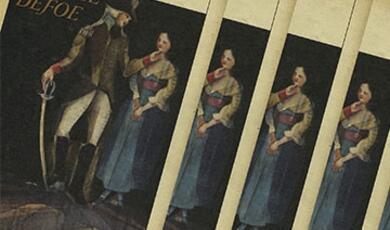The Rise and Fall of Sourdough: 6000 Years of Bread
Share
- Details
- Transcript
- Audio
- Downloads
- Extra Reading
The lecture will cover the history of the western world as seen through the food that nourished builders for the Great Pyramids, free men of the Roman Empire, the expansion of Christianity, and the development of Europe until modern science and technology replaced complex ecosystems of sourdough cultures with monocultures of fast, commercial, and comparatively tasteless yeast.
Download Transcript
23 March 2017
The Rise and Fall of Sourdough:
6,000 Years of Bread
Professor Eric Pallant
The story of human civilization - our developing relationship to nature, to food, religion, science, time, and one another - can all be told by a loaf of freshly-baked, warm-from-the-oven sourdough bread. The fact that for most of you the very mention of fresh-baked, homemade bread already sets half your mind wandering is an indication that bread, and here I am speaking of real bread, not something that comes embalmed in a multi-hued plastic bag, is something primal. The aroma of bread baking in an oven is enough to make us unconsciously lick our lips with anticipation.
To begin I must take you back more than 10,000 years. For all of human history up to this point, to eat meant to gather or to hunt. Let us date the beginning of human evolution around four million years ago. Early societies of people that looked a lot like us, and most definitely not at all like apes, were around 100,000 years ago. There was early speech, music, clothing, even rituals. Nevertheless, from the moment that the first limbs of human evolution branched from the tree of similar mammals until 8,000 BCE, when the Copernicus of her day invented planting and harvesting, people ate essentially the same food as bears: some meat, a little fish, and berries when they were in season, and a few palatable looking nuts and seeds.
To fully understand the invention of bread, we must first discover the domestication of wheat. Without wheat, there really is no bread. Other grains and legumes – barley, maize, lentils, rice, all domesticated about the same time as wheat – maybe ground to flour, mixed with water, even kneaded and then baked. Of all the grains, only wheat contains enough of the proteins that make gluten so that a wet, kneaded, batter or a dough infected with wild yeasts and bacteria allowed to sit until it sours will rise when it is baked.
Ah, but wheat. How does that happen? Wheat is a grass, and like all grasses it flowers and produces seeds. The origins of bread, therefore, begin with a field of grass roughly 8,000 years BCE. The last great sheets of continental ice had receded only two thousand years prior. Mountaintop glaciers, once sliding deep into valleys, have also melted back to their high elevation aeries. What is today’s Levant, the countries of Israel, Syria, and Jordan, though they never bore the weight of continental ice sheets, the way Boston did, for example, have still undergone a dramatic change in climate. When the last ice age ended it was warmer, a little wetter. Flowers and grasses spread across stony plains and valleys.
Evidence of the planet’s first seed engineers, that is, the first human beings to manipulate the genetic propriety of wild plants, occurred in what is today called the Fertile Crescent. This is an arc of territory rising to the north along the shores of the eastern Mediterranean, east through Turkey and Armenia, and southeast into what was then Mesopotamia, and today is called Iran and Iraq. In Tell Aswad in southern Syria, in Jericho near the Jordan River delta, in Cafer Hayuk in southeast Turkey, and at Nahal Hemar on an Israeli cliff above the Dead Sea, archaeologists sifting soil for little grains of vegetable matter lost in the earth ten millennia ago reach the same conclusion. Something in the way humans interacted with cereal grasses changed. Soon thereafter, agriculture was invented and the relationship between plants and people, and people and people, would never be the same.
There is no definitive explanation. The Madame Curie, Leonardo, or Galileo of her era may have been a young girl who had learned from her mother that food could be recovered by running her fingers up the spike of wild Emmer. She could capture the seeds in the palm of her hand and place her gatherings in a little animal skin pouch. Later she learned to make something with them, porridge probably.
It is likely that the legendary scientist who invented agriculture is female because it is girls and women the world over that gather, plant, and cook. To this day, and throughout history, in pre-industrial societies of the Americas, Africa, and Asia women tend, men hunt.
In one of the many limestone caves that dot the Fertile Crescent we can envision an encamped family in the hills overlooking the Jordan, Tigris, or Euphrates Rivers. An oval of mud catches the eye of a gatherer as she departs for her day of collecting seeds. The mud draws her attention because it is darker than the sun-bleached limestone and gravel that covers so much of the landscape. In previous winter rains, and the rains before that, fine silt has settled in a small, oblong basin on the edge of a wadi.
Some dark brown humus has accumulated and a few spikelets of wild Emmer wheat have settled in the organic-rich mud. One of the female seed gatherers must have recognized the size and shape of the seeds in the mud as being from an edible plant, yet made the decision they were so encrusted as to be not worth the trouble. Water was too precious to be wasted on washing tiny grains.
As the growing day length of the Middle East’s winter sun shined on the patch of still-moist mud, the dark surface would have absorbed warmth and the wild Emmer seeds, now lightly covered and protected from desiccation, would have germinated. It takes about three days after a rain for wheat to sprout, but in addition to tiny green leaves poking out of the ground we need someone to notice them and more importantly recognize the value of what she is seeing.
She must have removed a few seeds from her animal-skin bag that she had collected from distant fields and sprinkled them on the ground. Perhaps she had first drawn a circle in the mud with her index finger. Within days she would have had sprouts, and within a week she would have been certain the same plants she searched for each day while her brothers hunted desert hares and oryx, were growing where she had planted them. For the first time, food could be made to appear where you desired, rather than where it wanted to grow.
This is how domestication began. When our ancient scientist’s plants matured, she harvested the seeds and ate most, but not all of them. She threw some back in the location where her first experiment took place. As she monitored the outcome, she would have recognized only those that received water would grow. (It will not be long before residents of The Fertile Crescent discover a God of Rain and a God of the Harvest and a God of Fertility: super humans with an ability to control conditions of plenty and destitution that seem to be out of the hands of mortals.) Birds and mice ate seeds thrown on bare rocks. Those annoying pests would have to be dealt with. Protecting her plants from weeds, which somehow appeared without explanation, will also become an essential part of her day.
The first large scale use of bread was in Ancient Egypt. In the years of the Old Kingdom of Egypt (2650 – 2134 BCE), when pyramids were rising like urban high-rises during a real estate boom, we have the first archaeological evidence of large-scale bread production and probably sourdough domestication. While we cannot be certain what recipes Egyptians were using, the production of bread and beer to feed tens of thousands of laborers gives rise to some interesting speculation about the quantity of grain that must have been produced, and the number of bakers it must have taken to keep an army of contractors stuffed with bread and stoked on beer.
In an archaeological dig undertaken by Mark Lehner, a renowned Egyptologist, began an excavation in the late 1990s. He uncovered The Lost City, a major urban complex from the Third Millennium BCE, 400 meters south of the Sphinx. More than fifty percent of the more than half a million pottery fragments unearthed by Lehner’s team were pieces of bread molds. Behind the double walls of an administrative building, probably guarded by royal administrators back in the day, his workers uncovered seven, or possibly eight, mud brick silos, probably storage silos for grain. There are querns for grinding flour in other locations, hearths, huge ash piles, storerooms of bread molds, and several bakeries. Lehner has calculated that with the addition of all the people necessary for support such as carpenters, potters, and metalworkers added to the estimate of 4,000 haulers, masons, and setters and another 1,200 men in the quarries, the total labor force might have been in the 20,000 range.
Additional experiments run by Lehner and sourdough microbiologist, Ed Wood, actually recreated sourdough bread eaten in Ancient Egypt. They used ancient grains, local water and salt, replica cooking molds of clay, fires from straw and donkey dung, and a sourdough starter cultured on locally captured yeasts and bacteria. For the record, Ed Wood, the microbiologist loved the authentic bread. Mark Lehner, the archaeologist, found it to be rather sour and not so pleasant. Nevertheless, we can conclude that without sourdough bread there would have been no pyramids, no Ancient Egypt, not at that scale, anyway, and later no Ancient Rome.
Moving ahead to the year zero on the Christian calendar, we know from Rome’s bureaucrats that both Julius Caesar and Augustus were giving free bread to 320,000 citizens per month. Each free man was receiving seventy-five pounds of wheat a month, enough to feed an extended family. Italy is not the right climate to grow that amount of wheat and thus a considerable proportion of the effort of Rome’s great armies and across its extensive empire were to ensure a steady supply of wheat was shipped to the capitol.
As an aside, the British Isles are a decent place to grow wheat just about up to Hadrian’s Wall. North of the wall, wheat plants find the climate too cold and wet. It is a climate for a less finicky plant like oats, which to this day remain the staple of Scotland and one has to wonder if Rome’s decision to limit the extension of its empire to a line now delineated by Hadrian’s Wall is somehow aligned with its preference for fresh baked bread over sticky, gummy porridge.
While inexpensive, or better still, free, bread in combination with regular showings of chariot races, gladiator duels, and lion feedings is an excellent means for maintaining a peaceful empire, if either corporeal or spiritual nourishment fell into short supply, there opened up a space for revolts against the Caesar. At the far eastern end of the Mediterranean, in the City of Bethlehem a baby is born to a virgin mother. One translation of Bethlehem, Beit Lechem, is house of bread.
Jesus’ first miracle, and the only one apart from his resurrection to be chronicled by all four of the Gospels, is Feeding the Multitude. With only five loaves of bread and two fish, Jesus oversees the feeding of a crowd of 5,000 people (well, not really people, but 5,000 men and unknown thousands of women and children). He directs his disciples to break the loaves, eat some, and pass the remainder to someone sitting near to him until everyone was satisfied in body and in spirit. And still there were twelve baskets of leftover bread.
A sourdough starter, as any first century peasant would have been aware, lived for eternity. A small cask of starter contained an enchanted substance with the ability to grow, reproduce, and live forever. It could transform dough into something lighter, airier, and more heavenly. Its heady aroma of light fermentation would have permeated every household. Sourdough starter held the ability, as indicated by the Lord’s Prayer, to provide daily bread. But it could not supply our daily bread, today. Sourdough takes two days of preparation.
Early converts to Christ’s teachings would have heard the reference to bread and wine and been overtaken by deeply evocative olfactory recollections. In defining his body as bread, Jesus was saying essentially this. Partake of me and you too can be as eternal as your sourdough starters. And like your starters, which can be passed from one kitchen to the next, share me with a friend and they too can have immortality that is warm, sweet and as satisfying as a parent’s gift of sustenance. All this from a fresh loaf risen from an apparent death in the heat of hell’s ovens.
At his Last Supper Jesus lifts the bread, gives thanks to God, breaks a piece and declares, “Take. Eat. This is my body.” The Eastern Orthodox and Eastern Catholic churches maintain that Christ’s bread, like Jesus himself, is risen. In their view the four basic ingredients – fine white wheat flour, salt, yeast, and water – are symbols of resurrection. The bread rises not unlike Jesus from his bier.
With the decline of the Roman Empire, so too was there a diminution of world trade, education, and scholarship. In some ways we know less about the Dark Ages than we do about the Romans because there was neither time nor energy for most people to expend upon philosophy, writing, or cooking elaborate feasts. For a thousand years much of life was hand-to-mouth as serfs toiled in fields to bring forth enough grain to supply overlords, church officials, and if things went well, themselves.
Taken together – ignorance, famine, plague, warfare, theft, unscrupulous landlords, unnaturally cold winters, pests, and just plain malnourished fatigue – abundance was a rarity. If the rains were on time, temperatures were moderate, what insects blossomed were mostly of a variety the household chickens enjoyed, and the family cow discovered a heretofore hidden goldmine of nutritious grasses a family could, in principle enjoy a hearty month or year of cheese, bread, ale, and meat. In reality, what grain a serf was permitted to keep was by mandate of the lord of the manor ground into flour by the Lord’s miller and baked by the Lord’s baker, for a fee.
An oven was too expensive to construct and too costly to heat and so women of the house went to the miller with their grain and paid to have it milled into flour. She returned home, infected it with sourdough that was bubbling in a cask in their mud-floored home, and returned to the baker to pay him to cook it for her. More or less for a millennium.
What changes is urbanization, the Renaissance, and the Industrial Revolution. As the 16th and 17th centuries begin to break the hold of the Church, nation-states begin to replace fiefdoms, and laborers begin to move to cities, the relationship of workers to sustenance begins to change and slowly, so too, will the means of production.
In the year 1789, six thousand French women marched through dreary October rains to Versailles to demand a fair price for sourdough bread. It was hardly a spontaneous event. Food riots, like riots today in France, were already a well-practiced French tradition. While mass starvation had largely become a scourge of the past in pre-Revolution France, malnutrition was commonplace and life expectancy in France was still only about 35 years. When hunger either reigned or threatened, riots demanding nourishment were rarely far behind.
Irate over the perceived high price of sourdough bread in Paris, women rampaged. In the 1630s food riots erupted in Caen in the province of Normandy, in Pertuis and Reillane in Provence, and Angers in the Anjou. The number of riots increased through the seventeenth century so that during the thirty-year period of 1690 to 1720, France endured one hundred and eighty-two food uprisings. Between 1760 and 1789, the years leading up to the French Revolution, that number nearly quadrupled. On six hundred and fifty two occasions the people of France took to the streets.
Probably the most famous quote of the entire French Revolution, maybe of any revolution, is attributed to Marie Antoinette, except she never uttered the words, “Let them eat cake!”
To be precise the quote attributed to Antoinette is, “Qu’ils mangent de la brioche!” “Let them eat brioche,” a rich, eggy, cupcake sized bread, sporting a pronounced proboscis. If those poor peasants don’t have any bread, she is supposed to have recommended, then let them eat cake instead. In reality, the quote wasn’t attributed to the Queen until half a century after her head was guillotined from her body when pro-revolutionary historians handed her the line to justify the actions of anti-monarchists.
At the beginning of the seventeenth century, the Age of Exploration expanded from the seas to the heavens. Kepler, Galileo, and Newton published stories of a sky full of objects no one knew were there. Early telescopes allowed viewers to pierce heaven, a domain formerly belonging almost entirely to the Church. By mid-century, Galileo Galilee was using a compound microscope and in 1665, Robert Hooke, an optics enthusiast, published a scientific bestseller, Micrographia, replete with pictures of the world beneath his lenses. Hooke drew a parallel between exploring heaven with a telescope and inverting those lenses to see for the first time the invisible world on earth now brought to the human eye by way of microscopes. “…Under our feet, shews quite a new thing to us, and in every little particle of its matter, we now behold almost as great a variety of Creatures, as we were able before to reckon up in the whole Universe itself.”
It is Antony van Leeuwenhoek who gets credit for inventing modern microbiology mostly because Leeuwenhoek’s instruments could enlarge an object 275 times and resolve objects only a micron across. For the record a human hair is 100 microns across, and the period at the end of this sentence is around 500 microns. It would take nearly another two centuries before Louis Pasteur could prove definitively that yeast cells first observed by Leeuwenhoek were in fact living organisms, and moreover, that these microscopic cells, and not atmospheric chemical reactions, were responsible for leavening bread and fermenting beer and wine.
After six thousand years of raising bread with sourdough starter, researchers were closing in on an explanation for why a mixture of kneaded wheat and water would rise after it was dosed with a small amount of uncooked dough saved from yesterday’s bake. It was neither magical, nor religion, but science.
Richard Arkwright had the necessary business acumen to invent, borrow, coopt, and steal all the components to transform not only the manufacture of fabric, but the very nature of fabrication (note the origins of that word, fabrication), into the hands of a contraption. In the next century and a half skilled hand labor once used to make everything from underpants to crumpets were transferred to machines powered by fossil fuels. Say hello to the Industrial Revolution.
Arkwright patented what is known as a Water Frame, because the frame that held all the gears, turners, and winders – Arkwright’s patented 1769 model was built for him by a clockmaker – was powered by a water wheel rather than by draft horses. His yarns were consistently tight and smooth, absent the hairy projections typical of handspun and jenny yarn. An unlimited number of bobbins could garner yarn simultaneously as long as an operator was available to supply feedstock, piece together broken ends, and replace full bobbins with empties. No skill was necessary so Arkwright hired women and children because they were cheap. And he worked them through the night since the machine had no need to rest.
Arkwright opened his first mill in 1771 in Cromford, England. As he hired whole families to work, the town boomed like a gold strike. Within a decade he was paying more than a thousand laborers. Working twelve hour days did not leave much time for baking bread so just as important as a waterwheel and pretty soon coal to power Arkwright’s Water Frames were bakeries to fuel his workers.
At around the same time that microbiologists were perfecting the commercial production of thousands of pounds of nearly-pure yeasts, a Hungarian invention in the 1870s that used steel rollers in place of grinding stones produced fine white flour. Adding equal parts milk and water to a pearly white dough leavened with press-yeast, and for the first time a baker could make a loaf that was beginning to look like what we might find in a modern grocery. White, light, airy, and mostly without sour. It wasn’t completely acid-free as it was nearly impossible to keep all of the components of press-yeast free of lactic-acid making bacteria, but increasingly advanced methods greatly increased the ratio of yeast to bacteria. The result must have been heavenly for consumers accustomed to whole-wheat loaves that could break a toe if you dropped one.
Vienna Bread - so called because of its origins in that city - was such a marketing novelty that the Scientific Commission of the United States dispatched one of its scientists to the Vienna International Exhibition of 1873. Two years later, E.N. Horsford published an exhaustively detailed, Report on Vienna Bread. “Kaiser-Semmel,” writes Horsford, “presents a rich reddish-brown crust and delicately shaded yellowish, almost white interior. It is always light, evenly porous, free from acidity in taste or aroma, faintly sweet without addition of saccharine matter to the flour or dough, slightly and pleasantly fragrant, palatable without butter or any form of condiment, and never cloying upon the appetite.”
John Dauglish, an anxiety-ridden physician, gets the credit for marrying the concepts of engineering and sanitary nutrition into a single machine that could aerate bread without the use of biology. After studying medicine for four years in Edinburgh, Scotland he concluded that Scottish bread was “insipid” and aggravated his dyspepsia. Using mechanical skills he learned from his mother, he improved upon machines of earlier inventors creating a device that could inject carbonated water into a hermetically sealed container of flour. His first patent was taken in 1856. And soon thereafter came the Aerated Bread Company.
Bread dough leavened with shots of gas and kneaded with mechanical arms would have added advantages. No more dousings of perspiration dripped by bakers tossing hundreds of pounds of dough about in basement kneading troughs. Bakers would not be tempted to knead the dough with their bare feet. When Pasteur discovered yeast he also was busy identifying other microscopic organisms, which became known as germs. Yeast were awfully close relations to germs and if bread could be made without them, all the better. And in a Victorian age of Temperance, the absence of yeast would also mean the absence of any association whatsoever with alcohol. No food product could be more sanitary than aerated bread.
Regarding questions of labor and time, however, there was not much dispute. A batch of dough could be prepared in thirty minutes rather than eight to ten hours. No longer would bakers be required to begin their tasks before midnight hauling large sacks of flour, inhaling dust, hand kneading in overheated bake rooms, and going without sleep until late the next day. The average lifespan of a nineteenth century baker in England was just forty-two. Night work in poorly ventilated basements could be extinguished as Dauglish’s machine could be run night or day and were just as productive in daylight as they were at night and as was rapidly becoming the case in other industries some workers took the nightshift and others the day and from time to time they switched. Any bread that could be made by a machine was, without a doubt, going to be the bread of the twentieth century.
Aerated bread was free from all remnants of human contact. No hair, nails, sweat, flannel, cloth, or splinters from kneading troughs and shaping boards. As noted by Sir Benjamin Ward Richardson, M.D, and author of Total Abstinence in addition to his book called On the Healthy Manufacture of Bread: A Memoir on the System of Dr. Dauglish, the dough was never touched by human hand or foot, not exposed to the noxious fumes of the bake house, “nor to the emanations escaping from the skin and breath of the workmen.” The mechanical process of manufacturing aerated bread was perfectly clean and, “immeasurably superior to the barbarous and old, time-honoured system of kneading dough by hands and feet of workmen.”
Great Britain’s Aerated Bread Company opened its first tearoom in 1864 in central London. ABC, as the company was affectionately called, artfully combined the sale of nutritionally approved, sanitary, white bread, delicately arranged slices of meat, and Britain’s love for tea. Then ABC doubled its clientele by marketing to women.
Victorian women, in the 1870s and 1880s were demanding the right to vote. Moreover, they wanted to be able to eat in public without stigma and ABC happily obliged them. Scores of ABC tearooms served tea and sandwiches to small gatherings of unaccompanied women. The International Women’s Congress of 1899 recommended in its program that attendees frequent tearooms of the Aerated Bread Company and the New York Times made a point of calling out the value of ABC’s for women.
In the 1950s bread scientists in Great Britain invented a way of making bread that incorporated fat, extra yeast, and dough conditioners that made wheat capable of withstanding super high speed mixing. The Chorleywood Bread Process created an economical, fluffy, springy, very white bread capable of staying mold-free inside a plastic bag that could be manufactured in under four hours. The process was so successful that Chorleywood bread took over nearly the entire bread market of Great Britain and artisanal bakers largely went out of business.
It pays to disentangle that last paragraph. The strongest indication that bread making has changed is that there are now bread scientists. Not bakers, any longer, nor artisans, but scientists whose job it is to assemble bread from their chemical constituents. The goal is speed and economy and to achieve that requires additional yeast, fat, and chemicals. Taste is not a Chorleywood’s priority.
Fortunately, Great Britain is also home of the Real Bread Campaign, fighting for better bread in Britain. The Real Bread Campaign is a clarion call to remind consumers and bakers that real bread can be made with just four ingredients: flour, water, a little bit of salt, and leavening. Sourdough has been the leaven of choice for Western civilization for six thousand years.
If you have the desire, making your own sourdough bread does require a realignment of priorities. It might mean less time on Facebook or Instagram and instead more time making a mess in the kitchen and playing with your hands in your food. While sourdough bread does take two days to make, no step in the process takes longer than thirty minutes, and most steps in the recipe I use need only five minutes.
You do have to care for a sourdough starter the way you provide for any pet. It needs water and nutrients, but in exchange you will learn to make homemade bread that almost without fail will be better tasting, more nourishing, and far more satisfying than anything you can purchase in a chain store. Purchasing bread from a small bakery where the baker nurtures and cares for real bread will do, too, if your desire to eat bread is much greater than your wish to make it.
But if you want to join the Real Bread Campaign has a home baker, you can create your own sourdough starter or be given one by a friend. I have three starters, one made by my wife in the early 1990s, one from Saudi Arabia I purchased on the Internet, and one that came to me in the late 1980s from the 1893 gold rush of Cripple Creek, Colorado. This living ecosystem of wild bacteria and yeast have been a living zoo of history for a century and a quarter. Consider what you have in your possession that is that old, and in this day when a cell phone is obsolete in two years and a tape recorder is so ancient your children will not recognize one, ask yourself if any of your oldest items in custody are living as opposed to inanimate. A sourdough culture is a family heirloom I have shared with my children, friends, and neighbors.
Please let me know if you would like some starter and I will happily share. Sourdough holds within it the history of western culture, a living symbol of the sustenance upon which humans in the Middle East, Europe, Central Asia, and the Americas have relied for sixty centuries.
© Professor Eric Pallant, 2017
Part of:
This event was on Thu, 23 Mar 2017
Support Gresham
Gresham College has offered an outstanding education to the public free of charge for over 400 years. Today, Gresham plays an important role in fostering a love of learning and a greater understanding of ourselves and the world around us. Your donation will help to widen our reach and to broaden our audience, allowing more people to benefit from a high-quality education from some of the brightest minds.


 Login
Login







